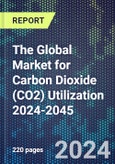There are a wide range of commercial opportunities in carbon dioxide (CO2) utilization, from aviation fuel to sportswear. This extensive report provides a detailed analysis of the growing global market for carbon utilization, forecasting growth in CO2 utilization across chemicals, fuels, polymers, building materials, agriculture and other sectors.
It assesses the addressable emissions sources by industry segment and competing carbon removal solutions while profiling key corporate players across the value chain spanning CO2 capture, CO2 conversion via thermochemical, electrochemical, catalytic and biological routes as well as mineralization concepts.
Multiple product opportunity areas are examined including synthetic hydrocarbon fuels and feedstocks, polycarbonates, polyols, industrial gases, enhanced oil recovery, yield boosting technologies, carbon nanomaterials and sustainable building products.
The report analyzes drivers, developments, investments, and challenges associated with transitioning CO2 into a viable renewable feedstock at scale. Regional market demand analysis covers North America, Europe, Asia Pacific, China and Rest of World geographies. Technology readiness and outlook is provided for different CO2 utilization pathways guiding research and adoption roadmaps.
Report contents include:
- Carbon Capture, Utilization and Storage (CCUS) market overview across industrial sectors and competing removal solutions
- Global market forecasts for Carbon Utilization from 2022 to 2045 - volumes and revenues
- Analysis of CO2 conversion technologies - thermochemical, electrochemical, biological etc.
- Assessment of synthetic hydrocarbon fuels, chemicals, polymers and building materials made from captured CO2
- Analysis of CO2 reuse across agriculture, horticulture, enhanced oil recovery
- Emerging concepts around mineralization pathways for carbon removal
- Review of investments, policies, developments, partnerships, and funding
- Profiles of 80 companies across the CCUS value chain (full list of companies profiled in table of contents)
- Evaluation of technology readiness, scalability challenges, projected adoption roadmaps
- Regional market demand analysis - North America, Europe, Asia Pacific, China, RoW
Table of Contents
1 ABBREVIATIONS2 RESEARCH METHODOLOGY
Companies Mentioned (Partial List)
A selection of companies mentioned in this report includes, but is not limited to:
- Aether Diamonds
- Aircela Inc
- Air Company
- Air Protein
- Algal Bio Co., Ltd.
- Algenol
- Arborea
- Arkeon Biotechnologies
- Asahi Kasei
- Avantium N.V.
- Azolla
- Blue Planet Systems Corporation
- BluSky, Inc.
- Brilliant Planet
- C4X Technologies Inc.
- C2CNT LLC
- Cambridge Carbon Capture Ltd.
- CarbiCrete
- Carboclave
- Carbo Culture
- Carbon Corp
- Carbonaide Oy
- Carbonova
- Carbon8 Systems
- Carbon Blue
- CarbonBuilt
- CarbonCure Technologies Inc.
- CarbonFree
- Carbon Limit
- Carbon Recycling International
- Carbon Sink LLC
- Carbon Upcycling Technologies
- Celanese Corporation
- CERT Systems, Inc.
- Chiyoda Corporation
- CleanO2
- CO2 Gro, Inc.
- Concrete4Change
- Coval Energy B.V.
- Covestro AG
- CURE
- Deep Branch Biotechnology
- Dimensional Energy
- ecoLocked GmbH
- Electrochaea GmbH
- Empower Materials, Inc.
- enaDyne GmbH
- Fairbrics
- Fortera Corporation
- GreenCap Solutions
- Greenore
- HYCO1, Inc.
- 1point8
- LanzaJet
- Lanzatech
- Liquid Wind AB
- Low Carbon Korea
- Low Carbon Materials
- Made of Air GmbH
- Mars Materials
- MCi Carbon
- Mineral Carbonation International (MCi) Carbon
- Neustark AG
- Newlight Technologies LLC
- Novo Nutrients
- Oakbio
- Obrist Group
- O.C.O Technology
- OxEon Energy, LLC
- Oxylum
- Paebbl AB
- Phytonix Corporation
- Prometheus Fuels, Inc.
- Prometheus Materials
- Seratech
- SkyNano Technologies
- Solar Foods Oy
- Solidia Technologies
- Synhelion
- Tandem Technical
- Twelve
- UP Catalyst
- ViridiCO2








